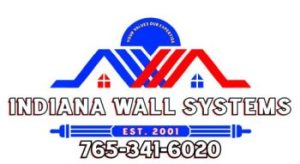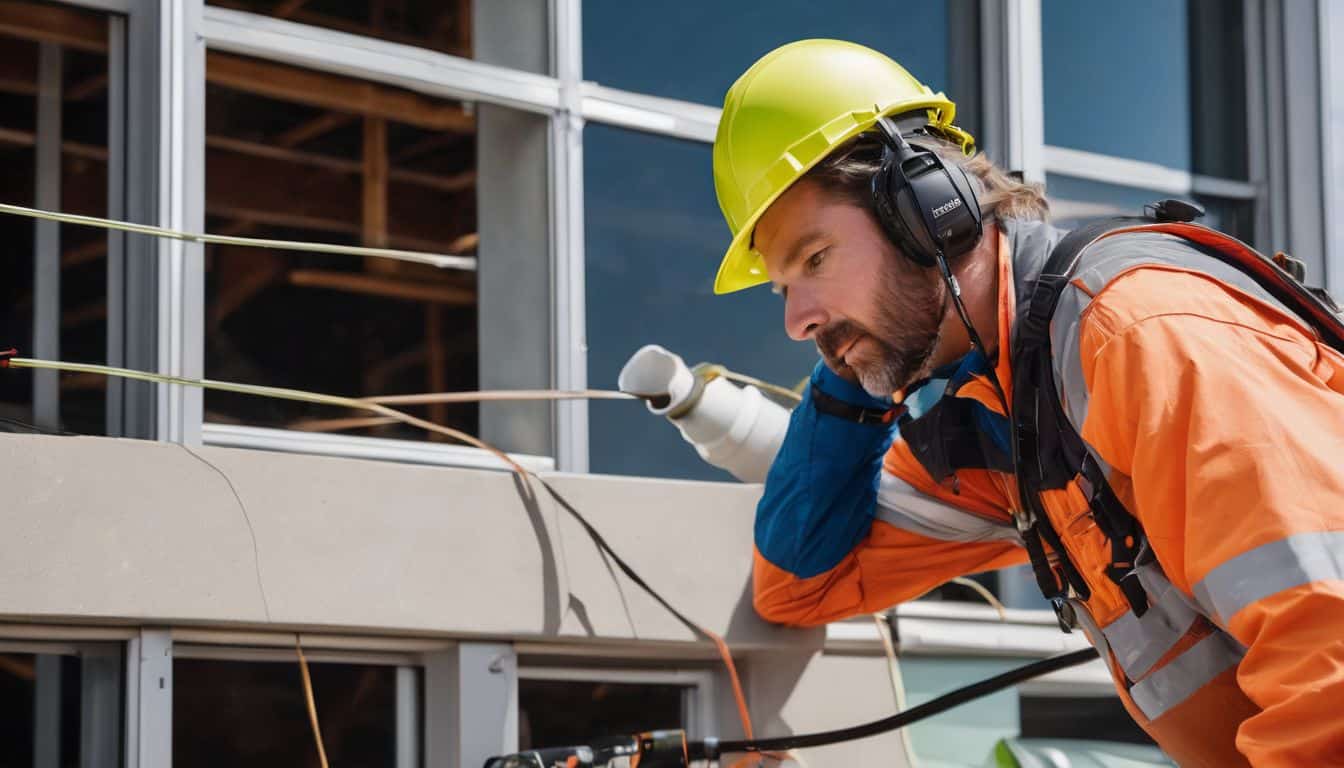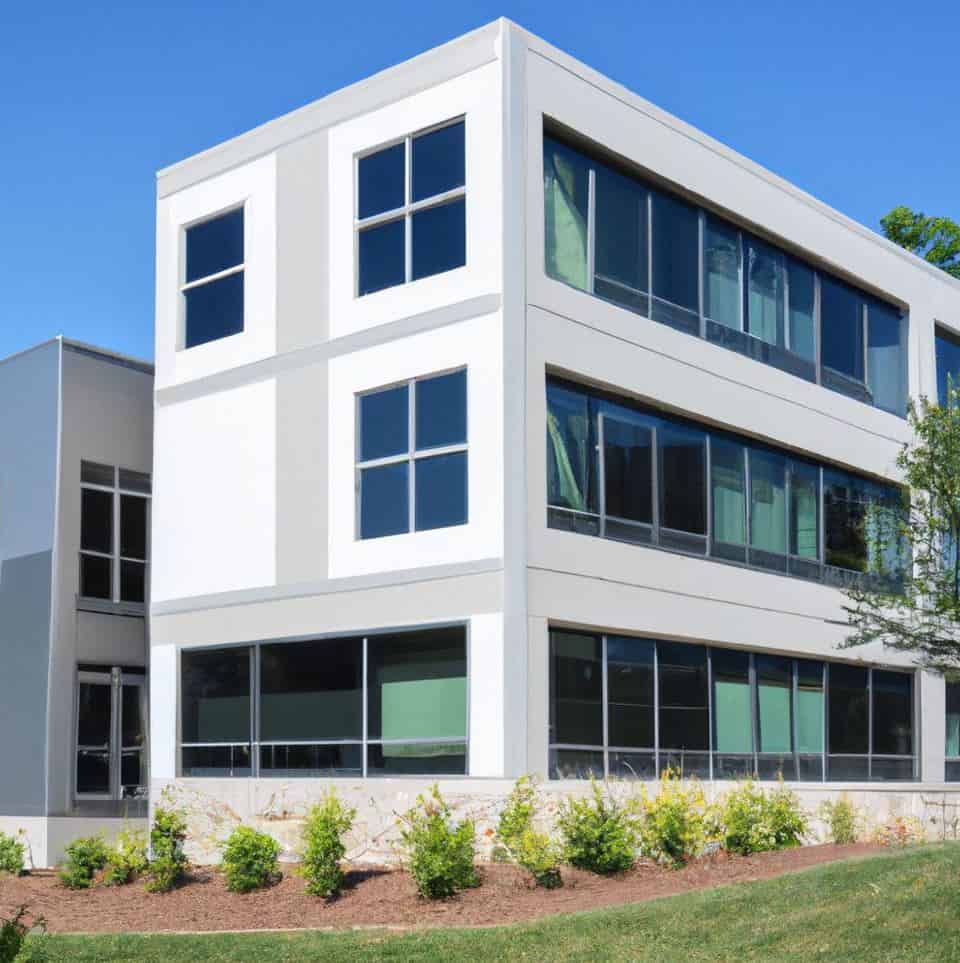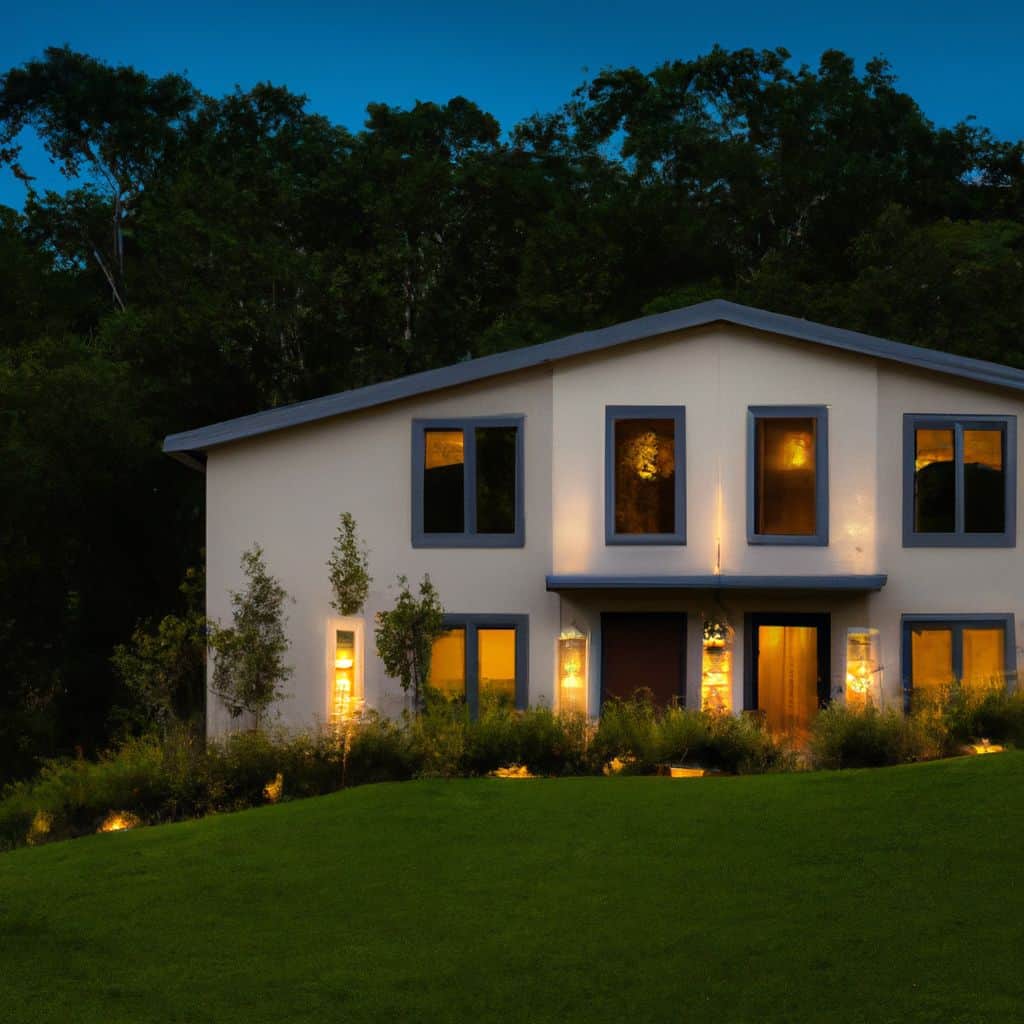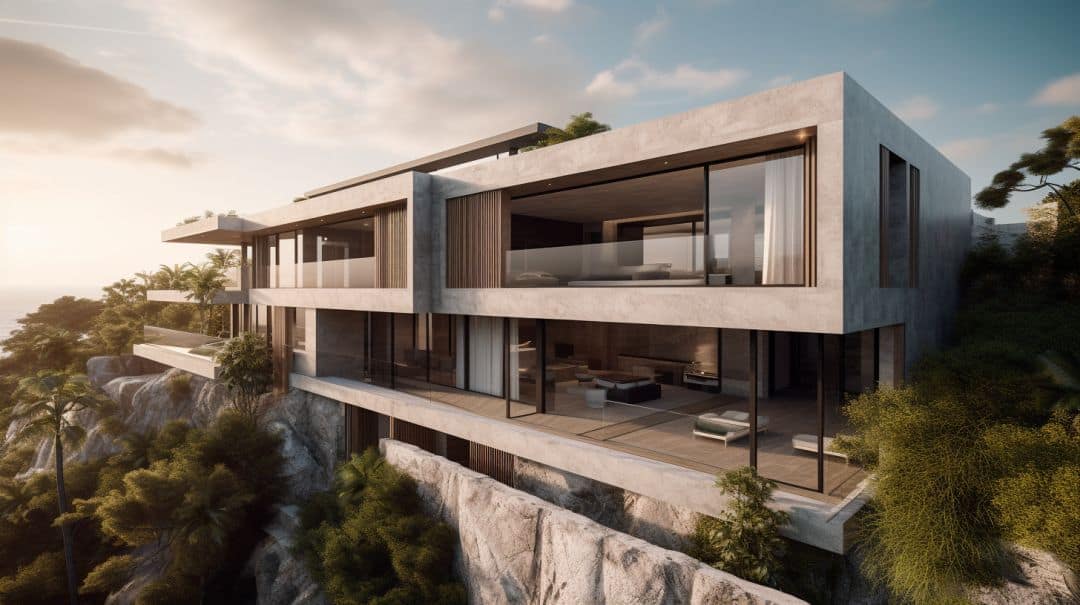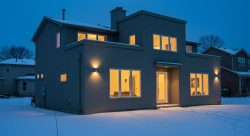Stricter Codes are Here – Discover How EIFS Naturally Meets CI Requirements and Helps Homeowners, Contractors, and Architects Save Time, Money and Energy
Building codes just got stricter—and if you’re planning any construction or renovation project in 2025, you need to know how continuous insulation requirements are reshaping the industry. The good news? Exterior Insulation and Finish System (EIFS) already delivers exactly what these new mandates demand.
After 22 years in the EIFS business, I’ve watched building science evolve. What we’re seeing in 2025 isn’t just a minor code tweak—it’s a fundamental shift toward thermal envelope performance that eliminates weak spots in your walls. Modern EIFS systems meet these requirements right out of the gate, making compliance straightforward for builders and homeowners alike.
Here’s the bottom line: if you’re choosing wall cladding options for your Indiana home, understanding these new rules will save you money, boost comfort, and future-proof your investment.
Key Takeaways
- 2025 IECC updates mandate continuous insulation across all structural members, eliminating thermal bridging in wall assemblies
- EIFS delivers integrated continuous insulation unlike traditional cavity-only systems that leave studs exposed to heat transfer
- Energy savings reach 20-40% compared to conventional framed walls with standard cavity insulation alone
- Compliance pathways are simpler with EIFS because the insulation board spans the entire exterior without interruption
- Modern EIFS systems include proper drainage planes and moisture management—solving the moisture concerns that plagued early barrier systems
What Changed in 2025 Energy Codes?
The International Energy Conservation Code (IECC) 2025 updates from the International Code Council represent the most significant shift in thermal envelope requirements in over a decade. These changes affect both residential energy code and commercial energy code projects across climate zones.
IECC 2025 Key Requirements
The updated energy conservation requirements now mandate:
- Continuous insulation systems that span across structural members
- Higher R-value requirements for above grade walls in most climate zones
- Enhanced air barrier integration to prevent infiltration losses
- Improved thermal continuity at joints and transitions
- Stricter whole wall R-value calculations that account for framing effects
Previously, builders could meet code with cavity insulation alone—stuffing fiberglass or spray foam between studs. That approach left wooden or steel framing members acting as thermal bridges, conducting heat in and out of the building. The new mandates recognize what building science has proven: those thermal bridges can reduce overall wall performance by 20-50%.
2025 IECC Continuous Insulation Requirements by Climate Zone
| Climate Zone | Region | Residential R-Value | Commercial R-Value | EIFS Thickness |
|---|---|---|---|---|
| Zone 3 | Southern States | R-10 CI | R-7.5 CI | 2.5″ EPS |
| Zone 4 | Mid-Atlantic, S. Indiana | R-15 CI | R-11.4 CI | 3.5″ EPS |
| Zone 5 ⭐ | CENTRAL INDIANA | R-20 CI | R-15 CI | 4″ EPS |
| Zone 6 | Northern States | R-20 CI | R-18.8 CI | 4.5″ EPS |
📍 Indiana is primarily Climate Zone 5
CI = Continuous Insulation | EPS = Expanded Polystyrene at R-4 per inch
Why the International Code Council Made This Move
Climate data and field studies drove these changes. Buildings lose tremendous energy through thermal bridging in standard wall assembly insulation. The International Code Council analyzed decades of performance data showing that continuous insulation vs cavity insulation isn’t even close—continuous insulation dramatically outperforms cavity-only approaches.
For Indiana specifically, most of the state falls into Climate Zone 5, which now requires:
- R-20 continuous insulation or equivalent whole-wall performance for residential construction
- R-15 to R-25 continuous insulation depending on commercial building type and wall assembly
- Demonstrated thermal envelope performance through energy modeling or prescriptive compliance
These aren’t suggestions. Local building departments enforce code mandated insulation levels, and inspectors now verify continuous coverage.
Understanding Continuous Insulation
Let’s break down what continuous insulation actually means—because this concept is central to why EIFS systems excel at meeting 2025 requirements.
Continuous Insulation Defined
Continuous insulation (CI) is insulation that runs continuously across all structural members without thermal bridges. Instead of insulation only between studs, CI covers the entire exterior of the building envelope.
Think of it this way: cavity insulation is like wearing a sweater with holes cut out for the ribs. You’re mostly covered, but cold air reaches your body through those gaps. Continuous insulation is like adding a windproof shell jacket over that sweater—complete protection with no weak points.
The Thermal Bridge Problem
In a typical wood-framed wall with only cavity insulation:
- Wall cavities might have R-19 insulation
- But wood studs (16% to 25% of wall area) have only R-1.25 per inch
- Steel studs are even worse—highly conductive
- Result: actual whole-wall R-value drops to R-11 or R-13
That’s a 30-40% performance loss from thermal bridging alone.
Thermal Bridging: The Hidden Energy Thief
❌ Cavity Insulation Only
⚠️ 30-40% Performance Loss
Thermal bridging through studs
✓ EIFS with Continuous Insulation
✓ 140% Better Performance
No thermal bridging
💡 The Bottom Line
EIFS eliminates thermal bridges by wrapping your entire building in continuous insulation—delivering 2.4x the effective R-value of cavity-only systems.
Continuous insulation systems solve this by adding an insulation layer outside the structural frame. Now heat must pass through both the cavity insulation AND the continuous layer—and there’s no direct path through the framing.
Types of Continuous Insulation Materials
Several insulation materials can provide continuous coverage:
- Expanded polystyrene (EPS) insulation: R-3.8 to R-4.4 per inch, economical, moisture-resistant
- Extruded polystyrene (XPS) insulation: R-5 per inch, higher density, excellent moisture resistance
- Polyisocyanurate insulation: R-5.5 to R-6.5 per inch, best thermal performance, foil-faced options
- Rigid foam insulation: general category including all foam board types
- Mineral wool: R-4 per inch, fire-resistant, vapor-permeable
EIFS typically uses EPS or XPS insulation boards because they deliver excellent thermal resistance value while remaining lightweight and workable for proper EIFS installation.
How EIFS Naturally Meets Continuous Insulation Mandates
Here’s where EIFS cladding becomes the obvious choice for energy code compliance. The system was designed around continuous insulation from day one.
The EIFS System Structure
A typical modern EIFS system consists of:
- Substrate (existing wall sheathing or masonry)
- Adhesive to attach insulation boards
- Insulation board (usually 1 to 4 inches of EPS or XPS)—this is your continuous insulation layer
- Base coat with embedded reinforcement mesh
- Finish coat in any color or texture
- Drainage plane and moisture management features (in modern water-managed systems)
That insulation board covers the entire exterior wall surface—windows, doors, and penetrations are wrapped and sealed. There are no gaps, no studs poking through, no thermal bridges.
Meeting R-Value Requirements with EIFS
Achieving required R-value requirements is straightforward with EIFS:
- 1 inch EPS = R-4
- 2 inches EPS = R-8
- 3 inches EPS = R-12
- 4 inches EPS = R-16
Need R-20 for residential compliance in Climate Zone 5? Install 4 inches of EPS (R-16) over a wall with R-5 cavity insulation, and you exceed the requirement with a whole wall R-value above R-20.
Compare this to trying to hit R-20 with cavity-only insulation in a 2×6 wall. Even with R-21 batts, thermal bridging through studs drops performance to R-13 or R-14. You’d need exterior rigid insulation anyway—so why not use EIFS and get the finished facade at the same time?
Integrated Air Barrier Integration
The 2025 codes also emphasize air barrier integration. Uncontrolled air leakage wastes more energy than many people realize—air infiltration can account for 25-40% of heating and cooling loads.
Modern EIFS creates an effective air barrier when properly installed:
- Insulation boards are adhered continuously to the substrate
- Seams between boards are offset and covered by the base coat
- Penetrations are sealed with compatible sealants
- Mesh-embedded base coat creates a durable, flexible air-control layer
- Finish coat provides additional protection
This air leakage control often allows EIFS buildings to achieve ACH50 ratings (air changes per hour at 50 Pascals of pressure) well below code minimums. Tighter buildings mean lower HVAC loads and more comfortable interiors.
Moisture Management Done Right
Early EIFS systems (barrier EIFS from the 1980s-90s) had moisture problems because they trapped water. Modern water-managed EIFS solved this with:
- Drainage planes behind the insulation board
- Grooved or channeled boards that allow moisture drainage
- Weep screeds at the base to release collected water
- Proper flashing around openings
- Compatible sealants at transitions
The result? Moisture intrusion prevention that protects the building while delivering superior thermal performance.
Our approach at Indiana Wall Systems includes careful attention to flashing details around openings and transition details for CI—the spots where most moisture problems start.
EIFS vs. Other Wall Systems for 2025 Compliance
Let’s see how EIFS stacks up against other exterior cladding options when meeting the new building code requirements.
EIFS Energy Performance vs Brick
Traditional brick veneer over a frame wall needs added insulation to meet 2025 codes:
| System Component | Brick Veneer | EIFS |
|---|---|---|
| Base wall R-value | R-15 cavity insulation | R-15 cavity insulation |
| Continuous insulation | Requires separate foam board | Built-in 2-4″ insulation board |
| Thermal bridging | Still present through brick ties | Eliminated |
| Installation steps | Add foam, add brick ties, lay brick | Install EIFS system |
| Total cost | Higher (materials + labor) | Lower (integrated system) |
| Whole wall R-value | R-18 to R-22 | R-23 to R-31 |
Brick looks great, but it wasn’t designed for today’s energy efficiency standards. Adding the required continuous insulation to a brick wall creates complexity—you need longer ties, careful detailing at openings, and thicker walls. EIFS provides better insulation than traditional approaches while weighing far less and installing faster.
Wall System Comparison: Meeting 2025 Energy Codes
EIFS
✓ Insulation + Finish in One
Brick Veneer + CI
⚠ Needs Separate Foam Board
Fiber Cement + CI
⚠ Separate Insulation Layer
Insulated Concrete Forms
⚠ New Construction Only
🏆 Why EIFS Wins for 2025 Codes
EIFS delivers the highest R-value per dollar, installs quickly, and includes continuous insulation by design—no separate foam boards, complex tie systems, or costly retrofits required.
EIFS vs Fiber Cement
Fiber cement siding also requires separate continuous insulation:
- Fiber cement boards have virtually no R-value
- Must add rigid foam behind siding to meet codes
- Creates challenges with trim details and penetrations
- Cladding option that looks good but adds cost
With EIFS, the insulation and finish are integrated. You’re not paying twice for both a cladding system and a separate insulation layer.
EIFS vs Insulated Concrete Forms
Insulated concrete forms (ICF) do provide continuous insulation—they’re foam forms filled with concrete. ICF works well for certain applications but:
- Much more expensive than EIFS over conventional framing
- Requires specialized contractors
- Limited to new construction (can’t retrofit)
- Heavy—requires substantial footings
- Less design flexibility for architectural details
For most residential building mandates and commercial building mandates, frame construction with EIFS delivers better value.
Energy Savings and Performance Benefits
The real question for property owners: what do these 2025 energy codes and continuous insulation mandates mean for your wallet?
Quantifying Energy Savings
Research and field data show impressive results from continuous insulation systems:
- 20-40% reduction in heating and cooling costs compared to cavity-only insulation
- Lower HVAC loads allow smaller, less expensive equipment
- Reduced heating demand cuts winter fuel costs significantly
- Reduced cooling demand eases summer electric bills
- Energy savings over lifecycle far exceed initial premium (if any)
A typical 2,500 square foot home in central Indiana might spend $1,800 to $2,500 annually on heating and cooling with standard cavity insulation. With EIFS providing continuous insulation, that drops to $1,100 to $1,750—saving $500 to $1,000 per year.
Over a 30-year period, that’s $15,000 to $30,000 in savings. Factor in rising energy costs, and the numbers get even better.
💰 EIFS Energy Savings: Real Numbers
Typical 2,500 sq ft home in Central Indiana
Annual HVAC Costs
Cavity Insulation Only
Annual HVAC Costs
With EIFS Continuous Insulation
ANNUAL SAVINGS
36% reduction in energy costs
$8,000
10-Year Savings
$16,000
20-Year Savings
💡 These savings compound as energy prices rise—protecting you from future utility rate increases.
Thermal Comfort Benefits
Beyond energy bills, there’s the comfort factor:
- More uniform temperatures throughout the building
- Fewer drafts from air leakage control
- Reduced “cold wall” effect in winter
- Less temperature swing during extreme weather
- Quieter interiors (EIFS provides sound dampening)
Jeff Johnson from Indiana Wall Systems notes: “Homeowners tell us all the time that their EIFS homes feel more comfortable. The walls don’t feel cold in January, and the AC keeps up better in July. That consistent comfort is worth something—even beyond the lower energy bills.”
Payback Period for Energy Upgrades
When calculating payback period for energy upgrades, EIFS looks attractive:
For new construction, EIFS might cost 5-15% more than basic vinyl siding with added foam board—but you’re getting a premium finish that needs minimal maintenance. Payback period: 5-10 years from energy savings alone.
For energy efficient retrofits replacing failed siding, EIFS over existing walls can dramatically improve performance. If you need new cladding anyway, the insulation component is nearly free. Payback period: 3-7 years.
For deep energy retrofits on older buildings, EIFS transforms energy hogs into efficient structures. Combined with window upgrades and air sealing, these projects can cut energy use in half.
📊 EIFS Investment Returns
Based on typical 2,500 sq ft Indiana home
Initial Investment
EIFS premium over basic siding
(includes insulation + finish)
Annual Returns
Total annual savings
Payback Timeline
🎯 16-Year Payback Period
After break-even, every year adds $950 to your pocket. Over 30 years, EIFS pays for itself nearly twice over—and you still have a premium exterior that’s good for another 20+ years!
Installation Best Practices for Code Compliance
Meeting energy code compliance requires more than just choosing EIFS—proper installation matters.
Contractor Installation Practices
At Indiana Wall Systems, we follow strict protocols:
- Substrate preparation: Ensure sheathing is dry, flat, and properly attached
- Insulation board attachment: Use specified adhesive or mechanical fasteners per manufacturer requirements
- Board layout: Offset joints, maintain thermal continuity at joints
- Penetration sealing: Flash and seal all openings before installing EIFS
- Base coat application: Embed mesh properly for impact resistance and air sealing
- Finish coat: Apply per specifications for durability and appearance
- Drainage details: Install weep screeds, maintain moisture drainage plane
- Integration with fenestration systems: Detail window and door transitions correctly
These installation best practices aren’t optional—they’re required for warranty coverage and code-compliant wall systems.
⏱️ Typical EIFS Installation Timeline
Day 1: Substrate Prep & Inspection
Verify substrate is dry, flat, and structurally sound. Address any moisture issues. Install drainage plane if required.
Days 2-4: Insulation Board Installation
Attach EPS or XPS boards with adhesive or mechanical fasteners. Offset joints for thermal continuity. Flash all penetrations and openings properly.
Days 5-7: Base Coat Application
Apply mesh-reinforced base coat. This creates the air barrier and impact resistance. Allow proper cure time between coats.
Days 8-10: Finish Coat & Details
Apply final textured finish in your chosen color. Install trim accessories, weep screeds, and expansion joints. Final inspection.
Project Complete: Code-Compliant & Energy-Efficient
1-2 weeks for typical residential home • Documentation ready for inspection • Warranty in place
Compare to brick: 3-6 weeks • Fiber cement: 2-4 weeks • EIFS wins on speed!
Critical Details for Energy Performance
Pay special attention to:
Thermal Continuity: Don’t break the insulation layer. Even small gaps at corners or around penetrations reduce overall performance. Use compatible insulation materials to fill odd spaces.
Air Barrier Continuity: The EIFS base coat acts as your air barrier, but only if it connects to air barriers at the foundation, roof, and windows. This requires coordination during construction.
Flashing Around Openings: Water that gets behind EIFS destroys insulation and creates mold. Proper flashing details around openings are non-negotiable.
Expansion Joints: Large EIFS surfaces need control joints to manage movement. These must maintain thermal envelope performance while allowing flex.
Climate Zone Considerations
Indiana sits primarily in Climate Zone 5 (with small areas of Zone 4), which means:
- Cold winters require R-20 continuous insulation or equivalent whole-wall performance
- Moderate summers need attention to cooling loads
- Freeze-thaw cycles demand moisture-resistant details
- Heating degree days exceed 5,000—insulation pays off fast
Different regions have different climate zone insulation requirements. A system that works in Zone 3 (southern states) might underperform in Zone 6 (northern states). EIFS adapts easily—just adjust insulation thickness.
Compliance Pathways and Code Documentation
How do you prove your wall meets the new requirements?
Prescriptive Insulation Requirements
The simplest path: follow the prescriptive insulation requirements in the code tables. For residential energy code in Zone 5:
- Install specified R-value continuous insulation
- Use approved insulation materials
- Meet insulation thickness requirements
- Document installation with photos and specifications
EIFS with 4 inches of EPS over R-15 cavity insulation easily exceeds these prescriptive minimums.
Performance Based Compliance
Alternatively, use performance based compliance through energy modeling for buildings:
- Software like REM/Rate or EnergyPlus calculates total building energy use
- If modeled consumption meets target, you pass—even with different R-values than prescriptive tables
- Allows trade-offs: better windows might offset slightly less wall insulation
EIFS system modeling typically shows excellent results because the continuous insulation layer eliminates thermal bridging that other systems can’t avoid.
Documentation Requirements
Building inspectors want to see:
- Product specifications showing R-values
- Installation details and drawings
- Photos of work-in-progress (especially drainage planes and flashing)
- Contractor certifications (manufacturers often require certified installers)
- Energy calculations if using performance path
Work with experienced EIFS contractors who understand local building codes and documentation needs.
Commercial vs. Residential Applications
The 2025 energy codes affect commercial and residential buildings differently—but EIFS works for both.
Residential Building Mandates
For homes, the focus is straightforward:
- Meet R-value requirements for above grade walls
- Maintain air barrier integration
- Prevent moisture intrusion
- Keep costs reasonable for homebuyers
EIFS delivers on all counts for residential applications. From single-family homes in Fishers to multifamily developments, EIFS provides:
- Required thermal resistance value
- Attractive, customizable finishes
- Proven durability when properly installed
- Reasonable cost per square foot
Commercial Energy Code Requirements
Commercial construction faces tougher standards:
- Higher R-value requirements in many cases
- Stricter air leakage control (tested with blower door)
- Fire resistance standards for assemblies
- Building energy benchmarking in some jurisdictions
Modern EIFS meets these demands:
Fire Ratings: EIFS assemblies can achieve 1-hour or 2-hour fire ratings when installed over appropriate substrates with fire-resistant insulation boards. This satisfies fire resistance standards for most commercial applications.
Large Facades: EIFS installs quickly on large surfaces, keeping commercial construction on schedule. The lightweight nature of EIFS makes it ideal for structures where structural loads are a concern.
Flexibility: From small retail to large hotel restoration projects, EIFS adapts to various building types.
Office Buildings and Retail Spaces
Commercial property owners appreciate EIFS for:
- Fast installation = less construction financing cost
- Excellent façade performance = lower operating expenses
- Wide range of finishes = brand-appropriate appearance
- Easy repairs if damaged
We’ve completed projects ranging from 5,000 to 300,000 square feet. In every case, meeting the new energy conservation requirements was straightforward because EIFS cladding already provided the needed continuous insulation.
Future-Proofing Your Building Envelope
The 2025 codes are just the beginning. Energy standards will keep getting stricter.
Evolution of EIFS Technology
EIFS keeps improving:
- Smart EIFS systems with integrated sensors monitor moisture and temperature
- New insulation materials offer higher R-values in less thickness
- Advanced coatings provide better durability and self-cleaning properties
- Luxury EIFS finishes mimic stone, brick, or wood with stunning realism
These future trends in EIFS technology ensure the system remains relevant as building science advances.
High Performance Building Design
Leading architects now specify EIFS for high performance building design because:
- Passive House certification is easier with EIFS’s superior thermal envelope performance
- Net-zero energy buildings need maximum insulation—EIFS delivers
- Resilient building design requires durable, weather-resistant envelopes
- Green building rating systems reward continuous insulation
A future proof building envelope using EIFS won’t need expensive upgrades when codes tighten further in 2030 or 2035.
Carbon Footprint Reduction
Beyond energy codes, environmental concerns drive construction choices.
EIFS supports carbon footprint reduction through:
- Massive energy savings over building lifetime reduce emissions
- Lower heating and cooling loads mean smaller HVAC systems
- Sustainable construction practices minimize material waste
- Some manufacturers offer environmental product declarations showing lifecycle impacts
- Can contribute to LEED certification points
Choosing EIFS isn’t just about meeting today’s codes—it’s about building responsibly for tomorrow.
Common Concerns and Misconceptions
Let’s address some questions we hear regularly.
“Isn’t EIFS that stuff that causes moisture problems?”
Early barrier EIFS from the 1980s-90s could trap water if improperly detailed. Modern EIFS systems with integrated drainage planes solved this decades ago.
Today’s water-managed EIFS includes:
- Grooved insulation boards that channel water down
- Drainage mats behind the insulation where needed
- Weep screeds at the bottom to release water
- Proper flashing at all penetrations
Moisture management is built into every quality installation. We’ve seen EIFS walls stay dry for 20+ years in Indiana’s challenging climate.
“EIFS is expensive.”
Compared to what?
- EIFS costs less than natural stone or brick
- Costs roughly the same as fiber cement with required insulation
- Costs more than vinyl siding—but vinyl needs added foam board and doesn’t include finish
When you factor in the integrated wall systems approach (insulation + finish + air barrier in one), EIFS delivers excellent value.
Plus, long-term energy savings offset any initial cost difference within years. And EIFS needs less maintenance than many alternatives—no painting every 5-7 years, no caulking hundreds of siding seams.
“Can I retrofit EIFS on my existing home?”
Absolutely. EIFS works beautifully for retrofits.
Energy efficient retrofits using EIFS over existing walls deliver dramatic improvements:
- Assess existing walls for soundness
- Add drainage plane if needed
- Install EIFS over prepared surface
- Detail windows and doors for new wall thickness
- Enjoy transformed appearance and comfort
We’ve retrofitted countless Indiana homes—from Indianapolis to Carmel to Bloomington. The performance improvement is always impressive.
“What about repair and maintenance?”
EIFS is remarkably low-maintenance:
- Hose down annually to remove dirt
- Inspect caulking at penetrations every few years
- Touch up any damage (rare with proper installation)
Repairs are straightforward when needed. Small damaged areas can be patched without removing large sections. We keep repair costs reasonable—typically a few hundred dollars for typical damage.
Contrast this with brick (repointing costs thousands) or wood siding (rot damage spreads unseen). EIFS might be the easiest exterior to maintain long-term.
Why Choose Indiana Wall Systems for EIFS Installation
Meeting 2025 energy codes requires expertise, not just materials.
Our Experience and Certifications
Indiana Wall Systems brings:
- 22 years in the EIFS business
- 160 years combined experience across our team
- Certified to install EIFS from every major manufacturer
- Projects from 300,000 square-foot commercial to small residential
- Service across Indiana, Kentucky, Ohio, Tennessee, Michigan, and Illinois
We stay current on building standards and local building codes in every market we serve. When specifications change, we adapt immediately.
Our Approach to Modern EIFS
We only use modern EIFS systems with proper moisture management:
- Drainage planes on every exterior wall
- Careful flashing details around openings
- Compatible insulation board materials from trusted manufacturers
- Multi-layer base coat with embedded mesh for durability
- Quality finish coats that last decades
Every project gets individual attention—we don’t cut corners to save minutes. That’s why our customers are 100% satisfied before we call a job complete.
Warranty and Support
Our work comes with:
- 10-year workmanship warranty
- Manufacturer material warranties (up to lifetime on some products)
- Ongoing support if questions arise
- Available 6am-5pm weekdays, 9am-12pm Saturdays
- 24/7 emergency response for active commercial projects
When you work with certified contractors who understand building envelope science, you get long-term energy savings and peace of mind.
Getting Started with Your EIFS Project
Ready to build or renovate with confidence that you’ll meet the new codes?
Project Planning Steps
- Define your goals: New construction? Retrofit? Commercial or residential?
- Review energy requirements: What does your local jurisdiction require?
- Choose your system: Insulation thickness, finish style, color
- Get professional quotes: Compare qualified contractors
- Schedule installation: Plan around weather and project timeline
Timeline Expectations
Typical residential EIFS projects take:
- 1-2 weeks for average single-family home
- 2-4 weeks for larger homes or complex designs
- Longer for commercial projects depending on size
Weather affects scheduling—we avoid installing during rain or extreme cold. But properly planned, most projects stay on schedule.
Investment and Returns
EIFS investment varies by project scope:
- New construction: adds 5-15% to exterior costs vs basic siding
- Retrofit: comparable to premium siding with separate insulation
- Commercial: competitive with other exterior wall assemblies that meet code
Returns come through:
- Energy savings: hundreds to thousands per year
- Comfort improvement: hard to quantify but very real
- Property value: energy-efficient buildings sell faster and for more
- Reduced maintenance: fewer repair and painting expenses
Most importantly, you’ll meet building code requirements without stress. No risk of inspection failure, no need to add expensive fixes after walls are closed up.
Frequently Asked Questions
What is continuous insulation and why is it required in 2025?
Continuous insulation spans across all structural members without thermal breaks. The 2025 IECC mandates it because traditional cavity-only insulation leaves studs exposed, creating thermal bridges that waste 30-40% of wall insulation value. Continuous insulation eliminates these weak spots for better energy performance.
How does EIFS provide continuous insulation better than other systems?
EIFS integrates insulation boards as a core component covering the entire exterior wall. Unlike brick or fiber cement that require separate foam layers, EIFS combines continuous insulation with the finish in one system, eliminating installation gaps and ensuring complete coverage across all structural members.
What R-value does EIFS provide for residential buildings?
EIFS R-value depends on insulation board thickness. Typical installations use 2-4 inches of EPS providing R-8 to R-16 continuous insulation. Combined with cavity insulation, total whole wall R-value reaches R-20 to R-30, easily exceeding residential energy code requirements in all climate zones.
Can EIFS be installed over existing walls for retrofits?
Yes, EIFS works excellently for energy efficient retrofits. After assessing existing wall conditions, contractors install EIFS directly over prepared surfaces. This transforms older buildings into code-compliant, energy-efficient structures while updating appearance. Window and door trim adjusts for the additional wall thickness.
How much can I save on energy bills with EIFS?
Studies show 20-40% reduction in heating and cooling costs compared to standard cavity-insulation-only walls. For a typical Indiana home spending $2,000 annually on HVAC, that’s $400-$800 in yearly savings. Over 30 years, savings exceed $12,000-$24,000, far outweighing any installation premium.
Is EIFS suitable for commercial buildings?
Absolutely. Modern EIFS meets commercial energy code requirements including higher R-values, air sealing standards, and fire resistance standards. The system’s speed of installation, lightweight properties, and design flexibility make it ideal for office buildings, retail spaces, hotels, and multifamily construction.
What maintenance does EIFS require?
EIFS is remarkably low-maintenance: annual hosing to remove dirt, periodic inspection of sealants around penetrations, and prompt repair of any impact damage. Unlike wood siding, EIFS doesn’t rot. Unlike brick, it doesn’t need repointing. Most homeowners spend less than $50 yearly on EIFS maintenance.
How long does properly installed EIFS last?
Modern EIFS systems with proper moisture management regularly last 50+ years. The synthetic finish resists UV degradation, won’t peel like paint, and maintains appearance for decades. Many EIFS buildings from the 1980s-90s still perform well today after 30-40 years, and those used old barrier technology.
Take the Next Step Toward Code-Compliant, Energy-Efficient Walls
The 2025 energy codes aren’t going away—and they’ll likely get stricter over time. EIFS positions your building ahead of the curve with continuous insulation that exceeds current requirements while preparing for future mandates.
Whether you’re building new, renovating, or upgrading an older property, now is the time to choose a wall system that delivers:
- Proven energy efficiency with measurable savings
- Complete building code compliance without complications
- Superior thermal comfort year-round
- Long-term durability with minimal maintenance
- Design flexibility for any architectural style
At Indiana Wall Systems, we’ve helped hundreds of property owners navigate changing codes while creating beautiful, efficient buildings. Our expertise in EIFS installation ensures your project meets every requirement the first time—no surprises, no expensive callbacks, no inspection failures.
Ready to discuss your project? Want to see how EIFS can work for your specific building? Let’s talk about transforming your vision into a code-compliant, energy-efficient reality.
Ready to Meet 2025 Energy Codes with EIFS?
Get expert guidance from Indiana Wall Systems—22 years of EIFS excellence serving Central Indiana
Serving: Indianapolis • Carmel • Fishers • Zionsville • Greenwood • and all of Central Indiana
Indiana Wall Systems | 5202 W 700 S, Morgantown, IN 46160 | indianawallsystems@yahoo.com
We serve Indianapolis, Carmel, Fishers, Zionsville, and communities throughout central Indiana. From small residential repairs to 300,000 square-foot commercial projects, we bring the knowledge and skill your EIFS project deserves.
Don’t let new energy conservation requirements slow your project or inflate costs. Choose EIFS—the wall system engineered to meet today’s codes and tomorrow’s standards.
Request your free estimate and energy analysis today. Call (765) 341-6020 or visit centralindianastuccorepair.com/contact to get started.
